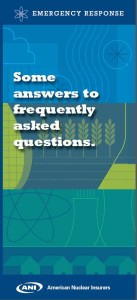While the likelihood of a nuclear accident is extremely low, if an accident does occur ANI is prepared to respond to the immediate emergency financial needs of the public with our emergency response (ER) program. In such an event, we would expect to provide immediate emergency financial assistance to evacuees who live and work within the recommended evacuation zone for reasonable out‐of‐pocket living expenses such as food, lodging, and transportation.

ANI has used mock emergency scenarios to test our ER program, to drill our response capabilities, and make our program more efficient.
ANI’s ER program is designed not only to help ANI prepare for an actual emergency, but to educate our policyholders and other stakeholders about ANI’s role in a covered nuclear emergency. At the request of our policyholders, ANI participates in nuclear industry drills, forums, and meetings with federal, state and local emergency management professionals. We also liaison with our policyholders’ support organizations, like the Nuclear Energy Institute (NEI) and Institute of Nuclear Power Organization (INPO) on emergency planning and emergency response issues. For example, in 2014 ANI made several presentations to the NEI Emergency Planning Working Group. Each of these forums allows ANI to demonstrate the value that we provide to our policyholders, government emergency response professionals and the public, and to maintain important relationships.
In 2014, ANI also updated our Frequently Asked Questions (FAQs) brochure and for the first time made it available on ANI’s website. We have provided this brochure to policyholder emergency planning and response personnel, policyholder communicators, risk managers, brokers, and nuclear industry organizations like NEI and INPO. The FAQ brochure helps show stakeholders the high level of preparation and planning undertaken by policyholders and ANI and spells out ANI’s role in a covered nuclear emergency.
ANI remains committed to continuously improving our emergency response program by working with our policyholders, NEI, INPO and other stakeholders.
